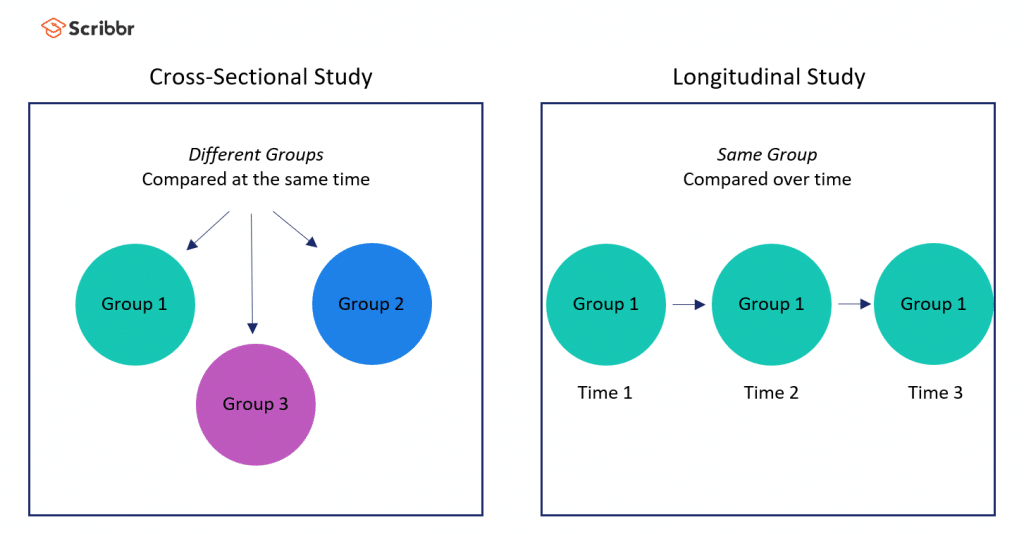Cross-Sectional Study Definitions, Uses & Examples
Table Of Content

A cross-sectional study is a research method that involves collecting data from a population at a single point in time. It aims to provide a snapshot of the population's characteristics, behaviors, or conditions, allowing researchers to explore associations and trends. A cross-sectional study provides valuable insights into a population’s characteristics, attitudes, and behaviors at a single point in time. As with any research design, cross-sectional studies should be used with other research methods to provide a complete study.
Cross-Sectional Design: Descriptive
We’ll review examples and explain the types of cross-sectional studies you might perform. We’ll also take a closer look at the benefits of this valuable research for the work you do. This may be a single snapshot for one point in time or may look at a situation at one point in time and then follow it up with another or multiple snapshots at later points; this is then termed a repeated cross-sectional data analysis. Cross-sectional studies look at a population at a single point in time, like taking a slice or cross-section of a group, and variables are recorded for each participant. Other disadvantages include low response rates, participants unable or unwilling to answer questions accurately and honestly, or the characteristic of the sample limiting the generalizability of the results.
Effect of socioeconomic characteristics and lifestyle on BMI distribution in the Chinese population: a population-based ... - BMC Public Health
Effect of socioeconomic characteristics and lifestyle on BMI distribution in the Chinese population: a population-based ....
Posted: Sat, 10 Jul 2021 07:00:00 GMT [source]
Enterprise Survey Software
Thoughtful planning, ethical conduct, meticulous data collection, and rigorous analysis are vital in uncovering valuable insights and contributing to the body of knowledge in your field. That's where innovative tools like Appinio come into play, revolutionizing data collection processes. By harnessing the power of real-time consumer insights, Appinio empowers researchers to make informed decisions swiftly.
Secure Surveys
While such studies cannot establish a causal link and do not quantify a variable, they can highlight a relationship that might be worth further investigation. One of the advantages of a cross-sectional study is that it plays a key role in developing hypotheses and in laying the foundation for a more comprehensive research project. They differ from time series analysis, in which the behavior of one or more economic aggregates is traced through time. As briefly discussed earlier, multiple cross-sectional surveys are used to assess the changes in exposures and outcomes in a particular population. Cross-sectional studies typically allow researchers to collect a great deal of information quickly.
Subgroup Analysis
For studies evaluating acute conditions (i.e., the common cold), the PR is favored (Alexander, 2015a). Similar to the OR interpretation, if the RR was equal to 1, exposure did not prevent or harm the exposed and unexposed groups. In other words, being obese did not affect the activity level (sedentary versus not sedentary).
White Label Surveys
A cross-sectional study is a valuable research methodology that allows scientists to determine the relationship between different variables and how they are connected with a specific outcome variable. Sometimes that period of time will consist of just a few years, while in other studies it could consist of decades, depending on the study’s purpose. Collecting data over a several years or decades allows researchers to examine how variables change over time. In this type of study, researchers do not manipulate any variables, but rather observe their interconnected influence on specific variables within the sample of individuals being studied. The primary goal of a cross-sectional study is to describe the prevalence of a specific condition or characteristic within a defined population at a particular moment in time. Another purpose of a cross-sectional study is to simultaneously describe multiple characteristics.
Such bias can compromise the generalizability of the study's findings, making it critical to employ rigorous sampling methods and consider potential biases during analysis. In economics, a cross-sectional survey can provide snapshots of employment trends within a specific region or sector. An example might involve analyzing the employment rates, job types, and economic sectors in a country at a given time. This data can reveal insights into the economic health, workforce distribution, and potential areas for economic development or policy focus, informing stakeholders and guiding decision-making processes. Cross-sectional studies cannot establish a cause-and-effect relationship or analyse behaviour over a period of time.
Longitudinal research collects data on the same sample over a longer period of time. One of the advantages of cross-sectional studies is that data is collected all at once, so participants are less likely to quit the study before data is fully collected. Groups can be affected by cohort differences that arise from the particular experiences of a group of people. For example, individuals born during the same period might witness the same important historical events, but their geographic regions, religious affiliations, political beliefs, and other factors might affect how they perceive such events. For example, a university might post a short online survey about library usage habits among biology majors, and the responses would be recorded in a database automatically for later analysis.
Induced abortion: a cross-sectional study on knowledge of and attitudes toward the new abortion law in Maputo and ... - BioMed Central
Induced abortion: a cross-sectional study on knowledge of and attitudes toward the new abortion law in Maputo and ....
Posted: Fri, 19 Jun 2020 07:00:00 GMT [source]

If the RR was less than 1, it implies that the exposure had a protective effect in that obese HIV participants were less likely to be sedentary than the unexposed group (not obese). A cross-sectional study does not need to have a control group, as the population studied is not selected based on exposure. These studies are quick, cheap, and easy to conduct as they do not require any follow-up with subjects and can be done through self-report surveys. Cross-sectional studies can be categorized based on the nature of the data collection and the type of data being sought.
Let's delve deeper into the crucial aspects of designing and planning a cross-sectional study. A single-ease research question is a straightforward query that elicits a concise and uncomplicated response. If the results show that Asian women would not buy the phone because it is bulky, the mobile phone company can tweak the design to make it less bulky.
In othere words, researchers just survey the target market or age group for a specific time period. That allows for including useful characteristics that benefit from changing variables. Researchers often use cross-sectional analysis to look at the dominant characteristics in a population because of their focus on the individual. A descriptive study is one that is designed to describe the distribution of one or more variables, without regard to any causal or other hypothesis.
By carefully considering these elements in the design and planning phase, you set a strong foundation for a successful cross-sectional study. Thoughtful decisions regarding your study population, sampling techniques, data collection methods, and ethical considerations will ultimately determine the quality and impact of your research. The primary goal of a cross-sectional study is to examine and analyze the relationships or associations between different variables within a population at a specific point in time. If a significant number of men from a particular age group are more prone to have the disease, the researcher can conduct further studies to understand the reasons. A longitudinal study is best used, in this case, to study the same participants over time. A cross-sectional study is a research methodology that involves collecting data on a sample of individuals at one specific point in time.
Unlike cross-sectional studies, researchers can use longitudinal data to detect changes in a population and, over time, establish patterns among subjects. Longitudinal studies require more time and resources and can be less valid as participants might quit the study before the data has been fully collected. Both cross-sectional and longitudinal studies are observational and do not require any interference or manipulation of the study environment. They can be beneficial for describing a population or “taking a snapshot” of a group of individuals at a single moment in time. Based on our experience, many businesses put minimal effort in determining the ideal demography for a cross-sectional survey.
Comments
Post a Comment